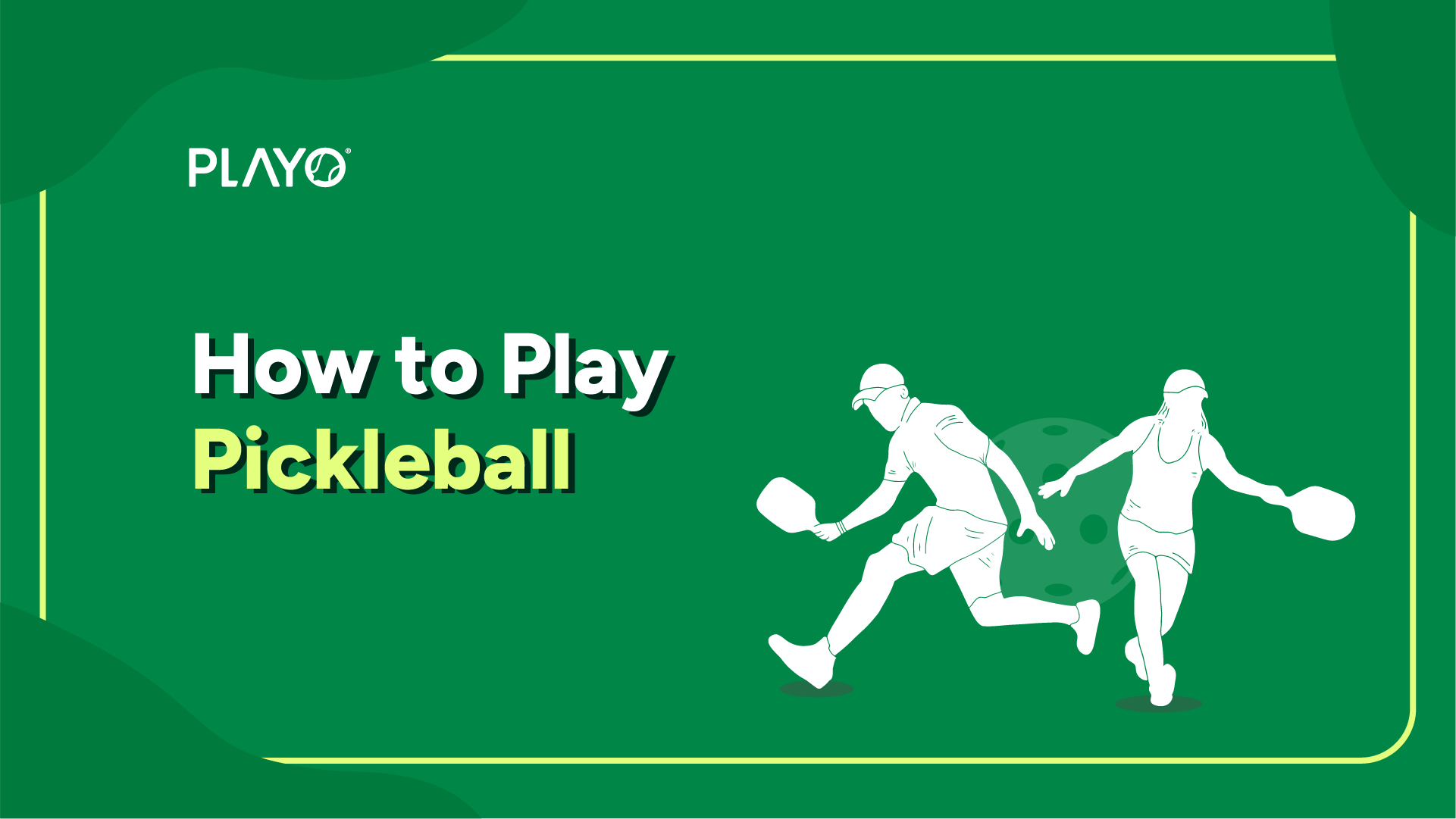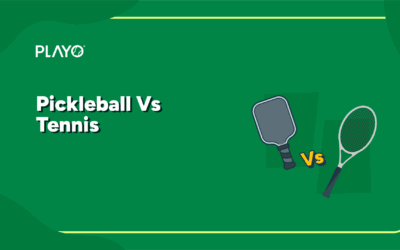Pickleball is a paddle sport played with a perforated plastic ball on a small rectangular court, either in singles (1v1) or doubles (2v2) format. The game begins with an underhand serve, followed by rallies where players must let the ball bounce once on each side before volleys are allowed. Points are scored when the opposing side commits a fault, such as hitting out of bounds or stepping into the kitchen zone during a volley.
What makes pickleball special is its perfect balance of simplicity and fun. It blends the elements of tennis, badminton, and ping pong, offering fast-paced rallies without demanding extreme athleticism. Whether you’re playing for fitness or fun, it’s a social and easy-to-learn sport that’s quickly winning hearts across the world.
In this guide, you’ll learn everything about how to play pickleball – from basic rules and scoring systems to court layout, common faults, and beginner tips to help you play confidently and enjoy the game to its fullest.
Basic Pickleball Rules
Serving Rules
- Serves must be made underhand, with the paddle making contact below the waist in an upward motion
- Both feet must stay behind the baseline when serving
- The serve must go diagonally cross-court into the opposite service area
- Two types of legal services in the pickleball court rules:
- Volley serve: Hit out of the air
- Drop serve: Drop the ball (no throwing/tossing) and hit after one bounce
- Let serves are live: If the serve touches the net but lands correctly in the service box, play continues
Service Sequence
- Doubles: Both players serve before the other team gets possession (except the game-opening serve- Only one player serves)
- Singles: Server serves from the right if their score is even, and from the left if odd. The server continues until a fault occurs
Read More: What is Pickleball?
Double Bounce Rule
- After the serve, the receiving team must let the ball bounce once before returning
- Then, the serving team must let the ball bounce once before playing it
- After two bounces, volleys and groundstrokes are allowed
The Kitchen (Non-Volley Zone)
The Kitchen, or Non-Volley Zone, is a 7-foot area on each side of the net. Players cannot volley while standing in this zone, but they can step into the kitchen to hit a ball that has bounced. If your momentum carries you into the kitchen after a volley, it results in a fault, which helps maintain fair play and prevents overly aggressive net rushes during rallies.
Pickleball Rules at a Glance
Understanding the basic rules of pickleball, like court size and scoring to serving, faults, and the kitchen zone, is key to mastering the game’s flow and fairness.
| Topic | Quick Summary |
| Court Size | 20 ft × 44 ft (same for singles and doubles) |
| Net Height | 36″ at sides, 34″ in the middle |
| Serve Rules | Underhand, cross-court, feet behind baseline |
| Scoring | Only server scores, play to 11 (win by 2) |
| Singles Play | Serve from right/left based on even/odd score |
| Double Bounce Rule | The ball must bounce once on each side before volleying |
| Volley Rules | No volleys in the kitchen (non-volley zone) |
| Kitchen Rule | Don’t step in or touch the kitchen when volleying |
| Service Rotation | In doubles, both players serve before switching sides |
| Faults | Ball out, into the net, kitchen volley, or bad serve |
Scoring in Pickleball
Traditional Scoring
- Only the serving side can score points
- Games are typically played to 11 points and won by 2
- In tournament settings, some games may go to 15 or 21
Calling the Score
In doubles, the score is called the server’s score, the receiver’s score, and then the server number (1 or 2). In singles, you only call the server’s score followed by the receiver’s score. For example, in doubles, if you say “4–2–1,” it means the serving team has 4 points, the receiving team has 2 points, and the first server is serving.
Rally Scoring (Optional)
- Points can be scored by either side, not just the server
- Sometimes used in tournaments or casual play for faster games
- It must be agreed upon beforehand
Pickleball Court Layout

- Court size: 20 feet wide by 44 feet long (same for singles and doubles)
- Net height: 36 inches at the sidelines, 34 inches in the centre
- Lines:
- Baseline: Back boundary line
- Sidelines: Outer edges of the court
- Centerline: Divides service areas
- Non-volley line: Marks the start of the kitchen
For a deeper understanding, read this – Pickleball Court Size
How to Play Pickleball Singles
Singles play is more physically intense and follows a slightly different rhythm compared to doubles. In singles, you serve from the right side when your score is even and from the left side when it’s odd. There is only one server per side, with no partner rotation, and because you cover the entire court on your own, strong footwork and good stamina become essential.
Common Faults and Violations
Faults result in the end of a rally. Common ones include:
- Serving into the net or out of bounds
- Volleying from inside the kitchen
- Failing the double-bounce rule
- Hitting the ball out of bounds
- Touching the net or posts during play
- Missing a serve or violating service rules
Pickleball Line Call Rules
- A ball that contacts any part of a boundary line is “in,” except on serves.
- Serves that land on the non-volley zone line are considered faults.
- In all other cases, if the ball hits the line, it’s a good shot.
- Line calls are typically made by players. If you’re unsure, call it in sportsmanship is important in pickleball.
Time-Outs and Game Management
- Each team may take two 1-minute time-outs per game
- Time-outs can be used for rest, strategy discussions, or momentum breaks
- In tournaments, referees may grant additional time for injuries or technical issues
Tips for Beginners
If you are new to this trendy sport, here are a few speedy tips:
- Keep your serve simple: Focus on getting it in, not smashing it
- Watch the kitchen line: No volleys should go in the kitchen zone
- Team up smart in doubles: Talk to your partner and move together
- Play smart, not hard: A well-placed shot beats a wild power hit
- Most importantly, have fun! Pickleball’s all about friendly vibes and good rallies
Conclusion
Now that you have a good understanding of how to play pickleball, serving and scoring, court design, and kitchen rules, you’re ready to take the court with confidence. Playing for fun, fitness, or some friendly competition, adhering to the official rules ensures the game is fair, speedy, and fun for all.
And if you ever get into a rule-related jam, the USA Pickleball Official Rulebook is your reference book for more specifics and tournament situations.
So pick up your paddle, locate a court, and let the games commence!
Frequently Asked Questions:
Pickleball is a paddle sport that blends tennis, badminton, and ping pong. Pickleball got its name from the term “pickle boat”, referring to a mix of leftover players, just like how the game combines different sports. There’s also a fun story about a dog named Pickles, but the boat theory came first.
Pickleball is played on a smaller court with paddles and a plastic ball, while tennis uses racquets and a larger court. It’s slower, easier on the body, and more beginner-friendly than tennis.
– Serve underhand and cross-court.
– Let the ball bounce once on each side before volleying.
– No volleys in the kitchen zone.
– Only servers can score points.
– Games are played to 11 and won by 2
Never volley in the kitchen! Hitting the ball out of the air while standing in the non-volley zone is a fault.
After the score is called, the server has 10 seconds to serve. Delaying beyond that counts as a fault.
Yes! Pickleball is simple, social, and easy to learn, great for all ages and fitness levels. You just need a paddle and enthusiasm.





0 Comments